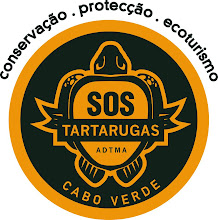The non-profit association, ADTMA SOS
Tartarugas was created in 2007 to address the killing of nesting loggerhead
(Caretta caretta) turtles taking place on the island of Sal. So many of these
endangered animals were being that extinction on the island was forecast for
2015.
A associação sem
fins lucrativos, ADTMA SOS Tartarugas foi criada em 2007 para combate á matança
de tartarugas loggerheads (Caretta caretta) em desova que acontecia na ilha do Sal.
Tantos destes animais estavam a ser mortos que se previa a extinção na ilha
para 2015.
Through intensive night time patrols and educational activities the association, in conjunction with various government institutions and authorities, has ensured a massive decline in the number of turtles being killed each summer. Founder, Jacquie Cozens states “When I arrived on Sal in 2007 it was common to see the remains of dead turtles littering the beaches, a sight, that thankfully, residents and tourists now rarely see. In 2014 only two turtles were killed on the nesting beaches in the south of Sal."
Através de patrulhas nocturnas intensivas e actividades educacionais, a associação em conjunto com várias instituições governamentais e autoridades, conseguiu um declínio massivo do número de tartarugas mortas todos os verões. A fundadora, Jacquie Cozens, afirma “Quando cheguei ao Sal em 2007 era comum ver o restos de tartarugas mortas nas praias, uma visão, que felizmente, residentes e turistas actualmente raramente vêem. Em 2014 apenas duas tartarugas foram mortas nas praias de desova no Sul do Sal.”
During the length of the project turtle conservation has gained a lot of momentum and through funds raised primarily from donations by tourists, SOS Tartarugas has been able to support projects on São Vicente, Santo Antão, Maio, São Nicolau, Santiago, Fogo and Brava.
Durante a duração
do projecto a conservação das tartarugas ganhou um grande impulso e através da
angariação de fundos, primeiramente de doações por turistas, a SOS Tartarugas
tem sido capaz de apoiar projectos em São Vicente, Santo Antão, Maio, São
Nicolau, Santiago, Fogo e Brava.
It is considered that the main objective of the association has been achieved and now it time to refocus and create a new project that reflects the changes that have taken place in Cabo Verde.
Consideramos que
objectivo essencial da associação foi atingido e que é altura de nos reorganizarmos
e criar um novo projecto que reflicta as mudanças operadas em Cabo Verde.
Although hunting has been reduced, a bigger threat exists through unsustainable development of Sal’s beaches. A large decline in the number of turtles nesting on Algodoeiro has been witnessed and this threat will increase further with the construction of the breakwater and more hotels. “It is possible for turtles and humans to co-exist, but unfortunately little attention has been paid to making the beaches turtle friendly and legislation governing the Protected Areas has not been implanted. Relocating nests to a hatchery is considered a last resort conservation action, but sadly, it is the only one possible due to the level of light pollution along the west and south coasts.”
Apesar da caça
ter sido reduzida, uma maior ameaça existe através do desenvolvimento não
sustentável das praias do Sal. Um grande declínio do número de tartarugas a
desovar na praia do Algodoeiro foi registado e esta ameaça continua a aumentar
com a construção do paredão e de mais hotéis. “É possível a coexistência entre
humanos e tartarugas, mas infelizmente pouca ou nenhuma atenção tem sido
prestada na criação de praias amigas das tartarugas e legislação a regular as Áreas
Protegidas ainda não foi implementada. Realocar ninhos para berçários é
considerado o último recurso em prole da conservação, mas infelizmente, é o
único possível devido aos níveis de poluição luminosa ao longo das costas Oeste
e Sul.”
Responsibility for patrolling the beaches and protecting turtles, nests and habitat has been passed to Projeto Biodiversidade, a new association created by former employees of SOS Tartarugas. Projeto Biodiversidade aim to continue the work started eight years ago and rise to meet the new challenges in the years to come.
A responsabilidade
pelo patrulhamento e protecção das tartarugas, ninhos e habitat foi passada
para o Projeto Biodiversidade, a nova associação criada por antigos empregados
da SOS Tartarugas. O Projeto Biodiversidade almeja continuar o trabalho
iniciado há oito anos atrás e ergue-se ao encontro de novos desafios nos anos
vindouros.
Projeto Biodiversidade can be contacted on /Projeto
Biodiversidade pode ser contactado em
594
3652 / info@biosal.org






